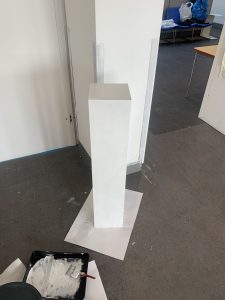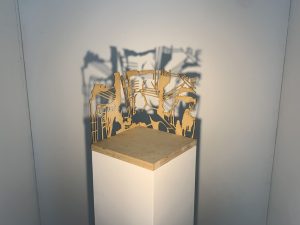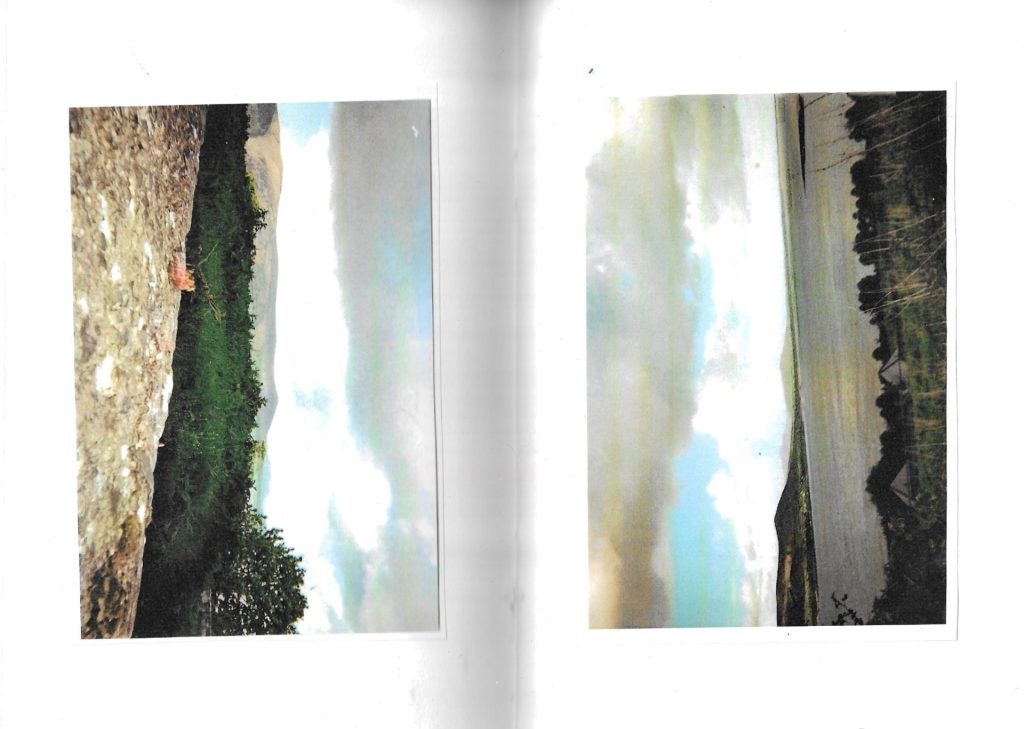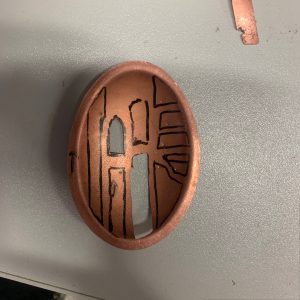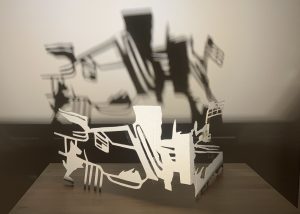For the final assessment, I wanted to continue making these abstract collages/cut-outs and working with shadows to create an installation. I thought the piece I made that I had bent at an angle was really interesting and wanted to continue looking at this kind of structure further. I began to jot down some ideas for a potential installation for my final assessment (Img. 1.), and considered using sound within it, but ditched this idea because I found the technicality of it a bit difficult, and worried about the sound imposing on other people’s work.
I made a plan of what a ‘successful structure’ would be like (Img. 3.) so that whenever I was drawing up a final design there would be a bit more sense to it rather than me placing parts of images anywhere. Overall I wanted to add more structure to it so that it could potentially stand on its own, so planned to use more landscapes or horizontal images along the bottom, as well as having a lot of the sections connected to ensure nothing could break off. I also wanted to keep in mind while drawing that the piece would fold in the centre, so had to be mindful that any lines stopped before that centre point, and the lines that would stretch across that would be secure.
The design that I drew up for a ‘final piece’ features me, or my younger self, at the centre of the structure, and everything extends out from this point- figures, landscapes, and linear forms of the bed frames in our dorm. For these parts, I traced sections that I liked from previous drawings that I had done. I then cut this out of a cereal box, using the same method as before in which I invert the drawing when photocopying it, stick it to the printed side of the box, and cut out the negative space using a box knife. Once this was finished, I folded the piece inwards so that it would sit on its own at a right angle.
I tested the shadows of this piece by placing it underneath my desk and shining my phone’s flashlight toward it, casting a shadow onto the wall behind it. I was happy with this piece because I feel like it has an ok mix of the elements from the photos. Initially, I planned on sticking with the cardboard however it was still quite flimsy just because the cardboard isn’t that strong. I started to think about alternative materials that I could use and thought back to the Bryony Knox workshop and the materials that I was introduced to there. I wanted to use something a bit more solid so that the material I was using could play a part in adding further meaning to my work (a need to solidify these memories before they fade/become too jumbled).
I spoke to the technician in the jewellery and silversmithing department and came to the conclusion that laser-cutting plywood would be the best option as it would give me that structural element that I was looking for, and was also somewhat similar to the cereal box. The technician took my cut-out and drew it digitally using vectors so that he would send it to the laser cutter. The finished laser cut is split into two, just because it would be difficult to bend the ply, but to support the two pieces, and act as a base for the work as a whole, the technician gave me a 20x20cm wooden panel along with the laser cut pieces.
After getting this completed I began to think of ways that I could display this. The main idea was to have this work sit on a plinth and have a light shining towards it so that shadows would be cast on the wall behind it. I was having a bit of difficulty trying to figure out what I would use for lighting, so decided to test what kind of lighting would work at home. As well as this, I was planning what size plinth would work best, and having a think about whether or not I should have something more to my piece because it felt a bit too ‘plain’.
At home, I tried to make a set up that resembled what I had drawn in my sketchbook my placing my work onto a small table against a plain wall and shining a lamp towards it. By doing this I was trying to figure out the position of the lights and what the shadows of the cut-out would actually look like. I tested this with a flashlight as well just to see if a smaller, more powerful light would work, but I think I like the expansiveness/more even spread of light that the lamp provides.
Once back at the University, I collected the plinth that was made to fit my work (20cm(L) x 20cm(W) x 100cm (H)), and glued all the parts of my ply structure together using wood glue so that I could get a clearer idea of what my final presentation would look like and finalise my plans. I painted the plinth white to clean it up a bit, and also to add some contrast to the work as a whole because I felt that the ply structure blended in with the plinth too much and took the attention away from it. This ended up looking really good and definitely brought the work together. My installation is situated in a corner of the foundation space in which there is less light, as I wanted it to be positioned in a dim spot so that I have a higher chance of getting some successful shadows.
At first, I had a bit of trouble with figuring out the lighting for my installation because I wasn’t able to find a 1 metre tall floor lamp which was the option that I was going for, and couldn’t find any smaller lights that I could attach to the side. Luckily there was a number of lights in the foundation art store, and after replacing the bulb I was able to get them to work and begin to think of a new lighting idea in which I could use these lights. To make the installation space more enclosed, my tutor added two more sections of wall onto the right side. With this extended wall, I was able to attach the light to the wall using the clamp on the end of it, and then twist the arm around so that the bulb was facing my work. It took a while to decide on the position of the lamp and plinth, as the closer the work was to the wall, the shadow was more detailed but not very expansive, whereas when it was closer to the light, the shadow was expansive but very blurry. After a bit of fiddling with the lamp head and the plinth itself, I found a good mid point in which was happy with the shadow produced.
Overall, I’m very pleased with my work from the main workshop. I think that my final outcome came naturally out of the work that I had been producing within the seven weeks and I was able to create a piece of work that explores the memories, or the lack thereof, that I have from my trip to Carlingford, and reflects this sense of disjointedness that I feel.
Final display of work:
—













